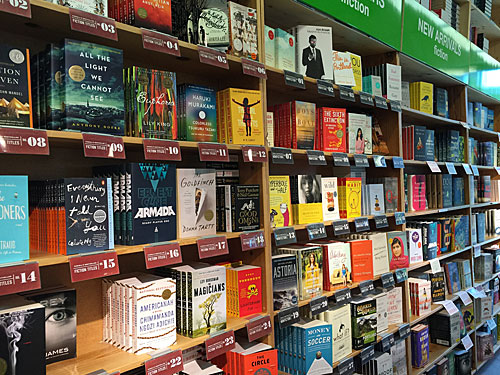Recently in my leisure reading, I noticed I had coincidentally chosen a handful of books that all had to do with mermaids or the circus. These weren’t back-to-back reads; rather they were each chosen independently over the course of a year or so, but there they were: mermaids, a randomly specific topic that had surfaced to the top of my fiction pile and left me to wonder why.
Perhaps you’ve noticed certain trends popping up in bookstores, libraries, on social media, or through recommendations—and once you did, you couldn’t un-notice these trends: dark teen/YA books with intense one-word titles (often with girls in ball gowns on the cover), fairy-tale twists featuring unfortunate yet gifted orphans, steampunk mysteries, Downton Abby-esque historical novels, the campus novel with the occasional secret society, and of course, the continuing popularity of dystopian fiction and paranormal romance, each with their own specific thematic offshoots. Another recent trend to note is coloring books for adults. What is it exactly that allows these trends to gain recognition and stay, at least for a while, in the popular crowd?
Certainly the frontrunner bestsellers of each category help launch a correlating trend. The success of teen trilogies such as The Hunger Games paved the post-apocalyptic road for others to follow suit: both the Divergent and The Maze Runner series grabbed page-turning attention and found their way onto the big screen. Adult fiction, as well, is still interested in exploring new angles of an imagined world’s-end future; the award-winning Station Eleven by Emily St. John Mandel comes to mind, along with alternate earth-threatening epidemics, such as insomnia (Karen Russell’s Sleep Donation), as a more subtle approach to the zombie apocalypse.
Following this track record, it’s possible that Erin Morgenstern’s The Night Circus, along with Sara Gruen’s Water for Elephants, might be responsible for my recent circusy/mermaid reads. Bestsellers may be supported as well by pop culture and current events. TV shows and movies play a large role in advertising which stories are big right now. Some research has posed that since 9/11, dystopian fiction provides an outlet to engage with “fear-based scenarios” and parallels a desire to understand cultural and political concerns. “People gravitate toward fiction to better understand the facts,” offers bestselling author David Baldacci.
Publishers are certainly aware of these rising trends, and they continue to capitalize on these popular categories. Thomas Colgan, executive editor of Berkley Books, says, “We’re always continuing with what works [and] have a tendency to publish a genre until we run it into the ground.” However, at the same time they look for “something wholly new that will resonate with readers in a big way. What that is, however, I don’t know.”
The upward trajectory of these hot-topic books may pose some potential problems in the world of publishing. First, there’s the question of quality. Although subjective in nature, the question still arises as to how much to acquire and publish. Is a book chosen truly for its merit and potential, or is the author simply getting in on convenient timing? How will the capitalization of trends impact non-trendy manuscripts? How much room is left over for taking risks on something new?
This concern extends to libraries and retailers attempting to curate their collection. With so much material out there, how do brick-and-mortar booksellers and librarians decide what to purchase and what to display or put forth as recommendations to inquiring patrons and customers?
While many factors contribute to the rise of these trends and the questions they bring about, the future of publishing will likely continue to see new directions grow out of the next big thing. Writers will have a unique opportunity to pay attention to these trends or ignore them; some may decide to jump on board while others will follow their own instincts. Publishers will weigh their yes’s and no’s with these trends in mind, considering factors of quality and content with popularity and risk. Booksellers and librarians will be faced with the continuing curating concern while maintaining a strong business-to-consumer relationship, especially for those to whom readers look for their next book to borrow or buy. But once the books are in the hands of readers, in a way the power shifts to the consumer. From mermaids to the end of the world, or whatever the next new trend will be, the response of readers will largely have a say in what sticks around and for how long.

